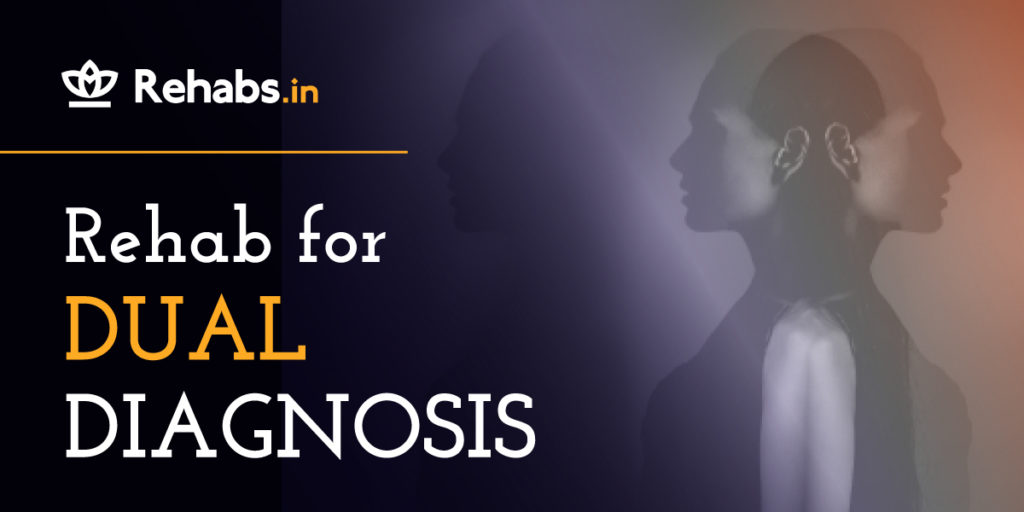Rehab for dual diagnosis

What is dual diagnosis?
The term dual diagnosis is fairly common in the de-addiction realm. A person is said to have a dual diagnosis or co-occurring disorders when they suffer from a substance use disorder as well as a mental health illness. There could be psychotic disorders, mood disorders, or personality disorders. More than half of the people who suffer from addiction also have a diagnosable mental health condition. In cases like this, it is of utmost importance to treat both conditions.
One might lead to another, but they are not necessarily related. In some cases, both conditions might develop simultaneously. It can often be difficult to pinpoint which one started first. One of the reasons why these conditions appear together is because they have common risk factors like genetics, stress, or trauma.
People with pre-existing mental health conditions might turn to alcohol or drugs to cope with their symptoms. This form of unhealthy self-medication or self-soothing can provide them with temporary comfort but worsen their symptoms in the long run. Certain mental health conditions might also change their brain chemistry to make them more vulnerable to addictions.
People who have substance use problems face challenges in all areas of life. It can also affect their brain, making them more susceptible to mental health problems. Problems in their relationships, at work, personal, and social life can increase their stress levels. Consumption of substances can, thus, in many ways, worsen a person’s mental condition.
Can dual diagnosis be prevented?
As mentioned earlier, there are certain common risk factors that are present in people who develop a co-occurring disorder. Both substance use disorders and other psychiatric illnesses start early on, around adolescence. If these signs are caught early on then, certain evidence-based preventive measures can reduce the chances of developing a dual diagnosis as an adult.
Adolescents can be screened for these disorders in schools and colleges. Some common risk factors include stressful life events, childhood trauma, child abuse or neglect, deviant peers, parental unemployment or substance use. Using these preventive measures can improve resilience and healthy coping skills among vulnerable adolescents. Family therapy can also be used to deal with any emotional problems or delinquent behaviour.
Treatment for dual diagnosis
The most essential step for proper treatment is an in-depth diagnosis. It is necessary to understand the conditions, the various symptoms, concerns and likely triggers to create an effective treatment plan. An integrated approach has been found to be superior to separate treatments.
Since the diagnosis has several aspects, the treatment will also have many dimensions. This might include medication, one-on-one psychotherapy, group support, and other holistic approaches. The treatment plan will vary according to the person’s condition. Creative integration of these treatments has been found to work best for comorbid conditions.
A residential facility helps in integrating treatment as they have all the facilities under one roof. Additionally, people who take treatment in a long-term residential program are more likely to remain abstinent than people who take outpatient treatment. Another factor that determines the effectiveness of the treatment is trust and connection with the therapist. In rehab, you will have access to your therapist every day. This can help you connect with them better.
It is necessary for people seeking treatment to stop the consumption of any substances during the treatment. A residential facility can provide you with the required 24/7 medical supervision and care. Your complete focus can stay on your recovery as you will be away from your usual stressors. Your treatment program may include the following modalities.
Medical-assisted treatment: A robust range of medications is available to control symptoms of various substance use disorders effectively.
12-steps: One of the most common approaches for addiction treatment, 12-step treatment has been shown to improve psychological functioning in people with comorbidities.
Cognitive Behavioral Therapy (CBT): This therapy is often used with dual diagnosis to modify maladaptive behaviours and improve coping skills. It can support recovery by making changes at both the thought and behavioural levels.
Dialectic Behavioral Therapy (DBT): This therapy is popularly used to manage self-harm behaviours. It was developed to treat people with borderline personality disorder, but its mindfulness-based and easy-to-apply techniques are used to manage various emotional and behavioural problems.
Contingency management: This treatment modality has been shown to increase abstinence in people with dual diagnosis. This is a type of behaviour therapy which involves giving patients reinforcement for certain behaviours. These can be like tokens which can be exchanged for some items or services. Many rehabs also celebrate abstinence anniversaries as a form of reinforcement.
Group Therapy: Along with one-on-one therapy sessions, group therapy sessions can be extremely beneficial. It can help you connect with people facing similar problems and get inspiration from each other’s journeys. Integrated group therapy (IGT) is a type of therapy developed specifically to treat co-occurring disorders.
Motivational Interviewing (MI): This is a non-judgmental, non-threatening approach used as an adjunct to regular psychotherapy. It helps build a connection with the therapist and keeps one self-determined on the path of recovery.
Therapeutic communities: Community feeling in any rehab is an important element. However, some rehabs design their treatment plan around this idea. They focus on re-socialisation and believe in people helping each other through their recovery journeys.
Holistic techniques: Along with these evidence-based techniques, most rehabs also incorporate some holistic aspects. You may be involved in practising yoga, meditation, ayurvedic treatment, mindfulness or massage therapy.
There is a plethora of therapies available, like trauma-focused therapies, seeking safety, Acceptance Commitment therapy, exposure therapy, etc. Depending on the condition, appropriate techniques might be used. To prevent relapse, experts recommend that one should remain in treatment even after completion of rehab. The intensity can be reduced gradually, but one can continue taking weekly or monthly follow-ups with their therapist or treatment providers.
One of the most common problems seen with dual diagnosis treatment is a high drop-out rate. Treatment adherence is often low in patients due to the complexity of the problem. Researchers are working to find new and effective ways of improving the existing treatment available.
If you or someone you know is experiencing symptoms of substance use or psychiatric disorder, reach out to a mental health professional. To browse our curated list of centres that specialize in dual diagnosis treatment, click here.
Sources:
Aase, D. M., Jason, L. A., & Robinson, W. L. (2008). 12-step participation among dually-diagnosed individuals: A review of individual and contextual factors. Clinical Psychology Review, 28(7), 1235-1248.
https://doi.org/10.1016/j.cpr.2008.05.002
Brady, K. T., Verduin, M. L., & Tolliver, B. K. (2007). Treatment of patients comorbid for addiction and other psychiatric disorders. Current psychiatry reports, 9(5), 374-380. https://doi.org/10.1007/s11920-007-0048-0
Dual Diagnosis. (n.d.).
https://medlineplus.gov/dualdiagnosis.html
Kelly, T. M., Daley, D. C., & Douaihy, A. B. (2012). Treatment of substance abusing patients with comorbid psychiatric disorders. Addictive Behaviors, 37(1), 11–24. https://doi.org/10.1016/j.addbeh.2011.09.010
Petry N. M. (2011). Contingency management: what it is and why psychiatrists should want to use it. The psychiatrist, 35(5), 161–163. https://doi.org/10.1192/pb.bp.110.031831
What are the treatments for comorbid substance use disorder and mental health conditions? (2021, April 13). National Institute on Drug Abuse. https://nida.nih.gov/publications/research-reports/common-comorbidities-substance-use-disorders/what-are-treatments-comorbid-substance-use-disorder-mental-health-conditions
Swendsen, J., Conway, K. P., Degenhardt, L., Glantz, M., Jin, R., Merikangas, K. R., … & Kessler, R. C. (2010). Mental disorders as risk factors for substance use, abuse and dependence: results from the 10‐year follow‐up of the National Comorbidity Survey. Addiction, 105(6), 1117-1128.
https://doi.org/10.1111/j.1360-0443.2010.02902.x












